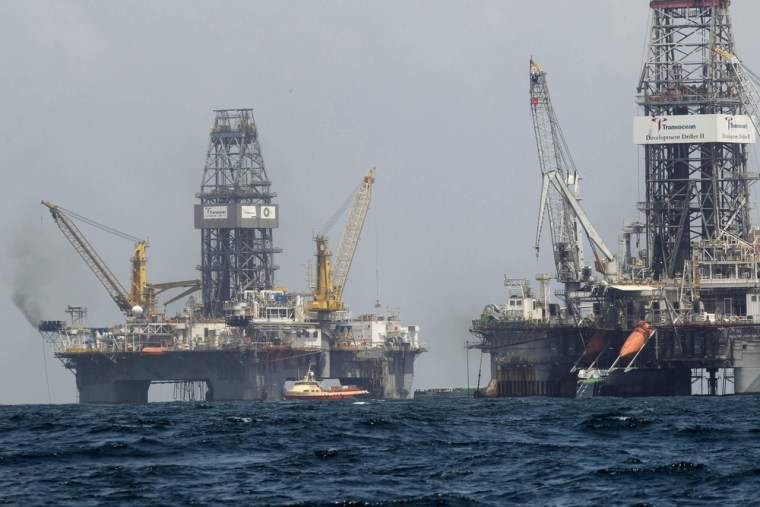Ships were getting back in place Sunday at the Gulf of Mexico site of BP's leaky oil well as crews restarted work on plugging the gusher before another big storm stops work again.
Piping for the main relief well being drilled was being reinstalled and should be ready by late afternoon, National Incident Commander Thad Allen told reporters Sunday. Drilling will resume once the piping is latched onto the well, and that should be around midnight, he added.
The piping had been pulled up from the sea floor as a precaution due to Tropical Storm Bonnie.
Allen added that "no anomalies" were seen around the stack that is containing the busted well and that pressure was still building, a sign that the well casing is holding and not leaking the oil somewhere else.
Once the last bit of pipe, or casing, is cemented in place near the bottom of the relief well this week, BP will begin a "static kill" the first week of August, Allen said.
"Generally the next week will be preps, making sure everything is ready to go," he said.
Allen had said the static kill, which involves pumping heavy drilling mud and cement into the well from the top, could start later this week after the casing is cemented in the relief well.
He said on Sunday that the timeline was "refined and revised" after consultations with BP.
While the static kill can start once the casing is in place, the relief well will still bore into the blown-out well near its bottom 13,000 feet beneath the seabed, Allen said.
Kent Wells, BP's senior vice president of exploration and production, said the static kill might plug the leak on its own. The relief well will confirm that or finish the job, Wells said.
"Those two work in tandem," Wells added.
Bonnie delayed work a week
Crews on Wednesday had plugged the chamber being drilled to reach the busted well and the temporary halt had an unpleasant consequence: Efforts to solidly seal the well were pushed back by at least a week, Allen said.
Completion now looks possible by mid-August, but Allen said he wouldn't hesitate to order another evacuation based on forecasts similar to the ones for Bonnie.
As peak hurricane season approaches, the potential for another storm-related delay is high.
"We're going to be playing a cat-and-mouse game for the remainder of the hurricane season," Allen said Saturday. Sure enough, another disturbance already was brewing in the Caribbean, although forecasters said it wasn't likely to strengthen into a tropical storm.
In the past 10 years, an average of five named storms have hit the Gulf each hurricane season. This year, two have struck already — Bonnie and Hurricane Alex at the end of June, which delayed cleanup of BP's massive oil spill for a week even though it didn't get closer than 500 miles from the well.
"Usually you don't see the first hurricane statistically until Aug. 10," said Dennis Feltgen, a spokesman for the National Hurricane Center in Miami. "The 2010 hurricane season is running just ahead of a typical pace."
Hurricane season ends Nov. 30.
Even though the evacuation turned out to be short-lived, it revealed one important fact: BP and the federal government are increasingly sure that the temporary plug that has mostly contained the oil for eight days will hold.
They didn't loosen the cap even when they thought they'd lose sight of it during the evacuation, although in the end, at least some of the real-time cameras trained on the ruptured well apparently kept rolling.
Storm tossed oil around
Ironically, the storm may even have a positive effect. Churning waters could actually help dissipate oil in the water, spreading out the surface slick and breaking up tar balls, said Jane Lubchenco, leader of the National Oceanic and Atmospheric Administration.
Beaches may look cleaner in some areas as the storm surge pulls oil away, though other areas could see more oil washed ashore.
"I think the bottom line is, it's better than it might have been," Lubchenco said.
By Wednesday, workers should finish installing steel casing to fortify the relief shaft, Allen said, and by Friday, crews plan to start blasting in heavy mud and cement through the mechanical cap, the first phase of a two-step process to seal the well for good. BP will then finish drilling the relief tunnel — which could take up to a week — to pump in more mud and cement from nearly two miles under the sea floor.
Meanwhile, British media reported that BP chief executive Tony Hayward was negotiating the terms of his departure ahead of the company's half-year results announcement Tuesday.
Hayward, who angered Americans by minimizing the spill's environmental impact and expressing his exasperation by saying "I'd like my life back," has been under heavy criticism over his gaffe-prone leadership during the spill.
